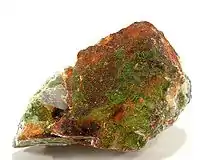Emmonsite
Emmonsite, also known as durdenite, is an iron tellurite mineral with the formula: Fe2(TeO3)3·2(H2O).[1] Emmonsite forms triclinic crystals.[1] It is of a yellowish-green color, with a vitreous luster,[1] and a hardness of 5 on the Moh scale.[2]

Emmonsite crystal spray from the Moctezuma Mine (3 mm image width)
| Emmonsite | |
|---|---|
 | |
| General | |
| Category | Tellurite mineral |
| Formula (repeating unit) | Fe2(TeO3)3·2(H2O) |
| Strunz classification | 4.JM.10 |
| Crystal system | Triclinic |
| Crystal class | Pinacoidal (1) (same H-M symbol) |
| Space group | P1 |
| Unit cell | a = 7.90, b = 8.00 c = 7.62 [Å]; α = 96.73° β = 95°, γ = 84.47°; Z = 2 |
| Identification | |
| Color | Yellowish green |
| Crystal habit | Thin to hairlike crystals, occurring in rosettes and sprays; also fibrous globular aggregates and crusts |
| Twinning | Noted |
| Cleavage | Perfect on {010}; good on {100} and {001} |
| Mohs scale hardness | 5 |
| Luster | Vitreous |
| Diaphaneity | Opaque to translucent |
| Specific gravity | 4.52–4.55 |
| Optical properties | Biaxial (-) |
| Refractive index | nα = 1.962 nβ = 2.090 nγ = 2.100 - 2.120 |
| Birefringence | δ = 0.138 - 0.158 |
| Pleochroism | Weak |
| 2V angle | Measured: 23° |
| References | [1][2][3] |
Emmonsite was first described in 1885 for an occurrence in the Tombstone District, Cochise County, Arizona. It was named for the American geologist, Samuel Franklin Emmons, (1841–1911), of the United States Geological Survey.[1][2]
Emmonsite is found, often with quartz or cerussite in the Tombstone, Arizona area.[2] It is also associated with native tellurium, tellurite, native gold, pyrite, rodalquilarite, mackayite, sonoraite, cuzticite and eztlite.[1]
References
| Wikimedia Commons has media related to Emmonsite. |
- Mineral Data Publishing, Handbook of Mineralogy pdf
- Emmonsite on Mindat website
- Emmonsite data on Webmineral.com
- Frost, Ray L. and Dickfos, Marilla J. and Keeffe, Eloise C. (2008) "Raman spectroscopic study of the tellurite minerals: emmonsite Fe23+Te34+O9.2H2O and zemannite Mg0.5[Zn2+Fe3+(TeO3)3]4.5H2O." Journal of Raman Spectroscopy, 39(12). pp. 1784–1788. Found at Queensland University of Technology website; Accessed September 15, 2010.
- W. F. Hillebrand, "Emmonsite (?) from a new locality," American Journal of Science, Series 4 Vol. 18, December 1904, P.433-434; doi:10.2475/ajs.s4-18.108.433. Found at AJS Online; Accessed September 15, 2010.
This article is issued from Wikipedia. The text is licensed under Creative Commons - Attribution - Sharealike. Additional terms may apply for the media files.